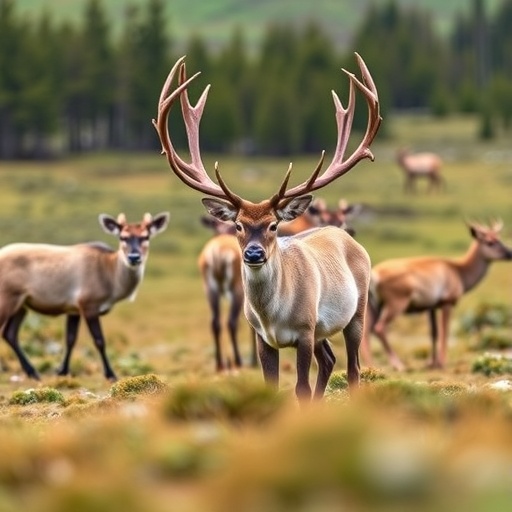In the vast icy expanses of the Arctic and subarctic regions, wild reindeer have long been symbolized as emblematic of these remote and fragile ecosystems. However, recent alarming studies reveal that their populations are undergoing significant declines, posing a pressing conservation challenge. Researchers have taken strides to develop an innovative environmental quality standard aimed specifically at assessing and safeguarding these iconic animals. This robust metric evaluates the status of wild reindeer populations by integrating multiple ecological factors that influence their survival and well-being.
This new environmental quality standard acts as a comprehensive tool that synthesizes population performance with habitat quality indicators. At its core, the standard incorporates quantitative indices that assess key dimensions: the demographic vitality of the reindeer populations, availability and health of lichen—a critical forage resource during harsh winters—and the extent of anthropogenic habitat fragmentation and loss. By quantifying these variables, scientists can generate a clear, objective categorization of reindeer population statuses into three understandable tiers: poor, medium, and good.
Application of this standard across Norway’s diverse wild reindeer habitats has yielded revealing insights. In a study encompassing 10 national parks and 14 smaller reindeer preserves, only a single population was deemed to have a “good” status. Conversely, 11 populations fell into the “medium” category, while 12 were classified as “poor,” signaling widespread ecological stress. This broad-scale assessment underscores a critical conservation crisis and emphasizes the urgency of coordinated management actions.
The population performance index, a cornerstone of the standard, is calculated using robust demographic data, accounting for birth rates, mortality, recruitment, and age structure. Such rigorous analyses provide an early warning system for population declines that might not yet be visible through direct observation alone. Coupled with this, the lichen resource index evaluates the availability and sustainability of this vital winter forage. Given that lichen growth is highly sensitive to environmental changes, its depletion serves as an indirect indicator of broader ecosystem health and forage carrying capacity.
Human-induced habitat loss and fragmentation contribute significantly to the reindeer’s precarious status. Urban expansion, infrastructure development, and land-use intensification create barriers that disrupt migration corridors, mating patterns, and seasonal movements crucial for reindeer survival. By quantifying these impacts within the standard, conservationists can better prioritize areas requiring restoration or protective legislation.
Critically, this environmental quality standard is designed not only as a diagnostic tool but also as a practical guide for wildlife managers and policymakers. Its simplicity—consolidating complex ecological data into clear status categories—facilitates transparent communication and effective decision-making. By highlighting the most vulnerable populations, the standard can direct conservation resources efficiently and inspire targeted interventions that address specific habitat or demographic concerns.
The development of this standard rests on interdisciplinary collaboration, combining expertise in population ecology, conservation biology, landscape analysis, and wildlife management. This multi-faceted approach ensures that the standard remains adaptive to diverse environmental pressures and can be calibrated to different geographical contexts beyond Norway. Ultimately, the goal is to establish a globally applicable framework that supports the long-term sustainability of wild reindeer across their range.
Reindeer serve as a keystone species in Arctic ecosystems, influencing vegetation dynamics, predator-prey relationships, and nutrient cycling. Their decline therefore has cascading effects on biodiversity and ecosystem integrity. The environmental quality standard thus represents an essential conservation innovation, offering a scientifically grounded method to track these complex ecological interactions and inform restoration strategies.
The urgency conveyed by this research is echoed by corresponding author Dr. Atle Mysterud from the University of Oslo. Dr. Mysterud stresses that the reindeer conservation community stands at a pivotal juncture, where timely action catalyzed by clear environmental standards can reverse negative trends. The hope is that this framework not only galvanizes conservation efforts but also educates the public and stakeholders on the intricacies and critical nature of reindeer ecology.
Looking forward, the implementation of this standard invites integration with emerging technologies such as remote sensing and genetic monitoring, which could enhance data precision and real-time assessment capacities. Such technological synergies would refine the standard’s effectiveness in detecting subtle changes in population health and habitat connectivity, thereby reinforcing adaptive management strategies.
Moreover, the researchers advocate for the standard’s use as part of broader ecosystem management plans, aligning with international conservation goals to preserve Arctic biodiversity under accelerating climate change. It offers a harmonized metric for cross-border cooperation, essential in managing migratory species like reindeer whose ranges span multiple jurisdictions and landscapes.
In summary, the pioneering environmental quality standard unveiled for wild reindeer conservation provides a timely and technically rigorous tool to confront a mounting ecological crisis. By delivering actionable insights through a blend of demographic, habitat, and anthropogenic impact indices, it equips scientists, conservationists, and policymakers with the clarity and precision needed to safeguard these emblematic creatures for future generations.
Subject of Research: Conservation standards and assessment of wild reindeer populations in the Arctic and subarctic regions.
Article Title: A quality standard for conservation of wild reindeer
News Publication Date: 8-Oct-2025
Web References: Wildlife Monographs Journal | DOI: 10.1002/wmon.70005
Keywords: Conservation biology, Biodiversity conservation, Conservation genetics, Endangered species, Ecosystem management, Wildlife, Wildlife management




